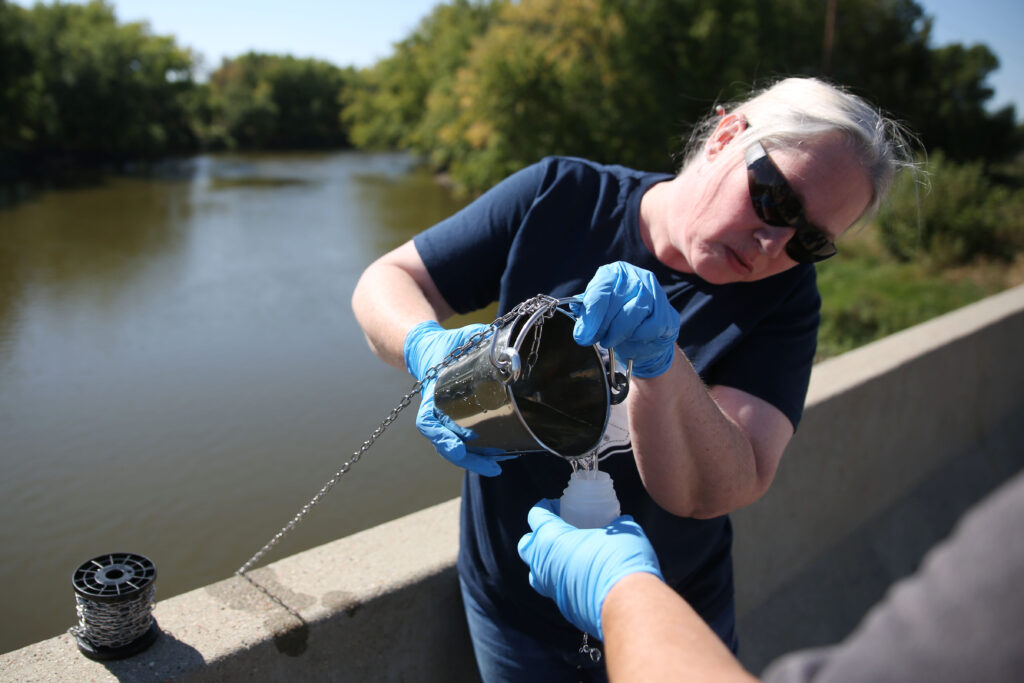Jenny Kozak, a master’s student at South Dakota Mines, recently collected water samples from the murky Big Sioux River as part of an important study aimed at assessing water quality for per- and polyfluoroalkyl substances (PFAS), also known as “forever chemicals.” The testing is being conducted at the request of the East Dakota Water Development District, which is eager to determine whether these contaminants are present in the river. The analysis is expected to cost the district a minimum of $100,000 and will involve testing 11 sites ranging from northeast South Dakota to the Iowa border, with multiple sample runs planned through 2025. Jay Gilbertson, the district manager, expressed hope that the results would show no PFAS, suggesting that the lack of information hampers proactive measures regarding water safety.
In addition to the ongoing PFAS testing of the river, a federally funded project from the South Dakota Department of Agriculture and Natural Resources is in the planning stages to clean up various contaminated sites in the area. This includes places like Falls Park and former rubble sites near the Sioux Empire Fairgrounds, which are being scrutinized for potential PFAS and other harmful contaminants that could affect the Big Sioux River. PFAS have been extensively used since the 1940s in numerous industrial and consumer products due to their water and grease-resistant properties. However, these substances do not degrade easily in the environment or the human body, with research linking exposure to adverse effects such as developmental and reproductive issues, as well as an increased risk of certain cancers.
Earlier this year, the federal government set new limits on specific types of PFAS in drinking water; however, these regulations pertain only to treated drinking water and do not extend to PFAS found in natural waterways. Notably, while the City of Sioux Falls is the only water system that draws water from the Big Sioux River, it rarely utilizes this source for drinking water. Instead, the city relies more on underground wells, although research indicates that under certain circumstances, river water can infiltrate these wells. Gilbertson pointed out a previous incident in which water treatment plants faced challenges due to increased hardness in their systems, attributed to water discharged from Lake Poinsett into the Big Sioux River, which affected downstream wells.
The critical importance of identifying PFAS in the Big Sioux River cannot be overstated. Should contaminants be discovered, public water suppliers can be alerted to adjust their sourcing strategies ahead of time. For example, they may be advised to cease using adjacent wells to the river, thereby preventing potential contamination of drinking supplies before it escalates into a public health crisis. The ongoing research is not only focused on the river itself but also on the potential for PFAS contamination to be present in wells located near significant military and civilian institutions. Notable detections have been found in wells near Ellsworth Air Force Base, Sioux Falls Regional Airport, and various National Guard facilities throughout South Dakota.
In Sioux Falls, authorities have proactively suspended 21 wells suspected of PFAS contamination. Following these findings, the city has implemented comprehensive testing of all raw water samples, including those potentially sourced from the Big Sioux River. So far, officials have not detected PFAS in these tests, although Gilbertson cautioned that a lack of detection does not rule out the presence of PFAS either upstream or downstream of the tested areas. Recently, a preliminary sample taken from Mount Rushmore National Memorial revealed PFAS levels exceeding federal limits by more than twice the acceptable threshold, highlighting the pervasive nature of these contaminants.
The South Dakota Association of Rural Water Systems, in collaboration with the EPA, is also investigating the presence of PFAS across 40 rural water systems statewide. Concurrently, various cities are conducting their own testing and submitting those results to the EPA. Meanwhile, researchers like Lisa Kunza from South Dakota Mines are focused on understanding the broader implications of PFAS contamination. Kunza, along with her team, is examining the effects of these substances on water resources, agriculture, and public health while searching for 40 different PFAS compounds in the water samples collected. Initial test results are expected to take anywhere from a month to several months to be processed, marking a critical step in potentially addressing public health concerns related to PFAS in South Dakota.

